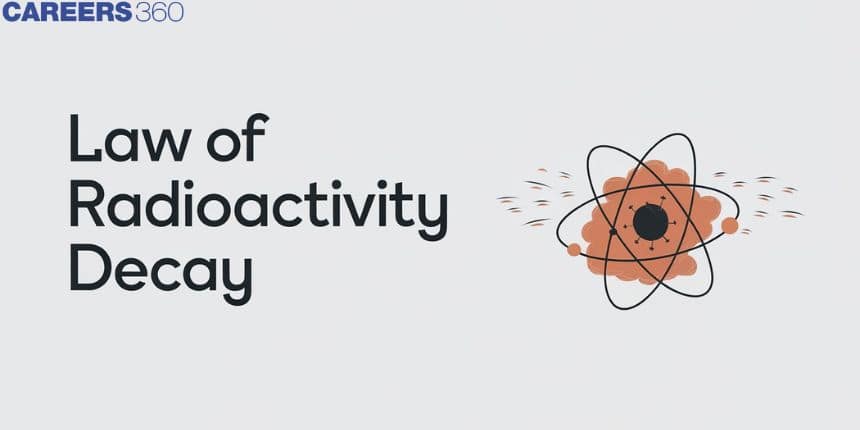Law Of Radioactivity Decay
The Law of Radioactive Decay elucidates the method through which unstable atomic nuclei lose energy. This occurs because the unstable core transmutes itself into another core element when it decays releasing some particles or electromagnetic waves in the process. For given radioactive compounds, the time-lapse for this change is always constant meaning that it occurs at a specific speed so that half of any given amount gets exhausted after some time.
JEE Main/NEET 2027: Physics Important Formulas for Class 10
NEET 2025: Mock Test Series | Syllabus | High Scoring Topics | PYQs
JEE Main: Study Materials | High Scoring Topics | Preparation Guide
JEE Main: Syllabus | Sample Papers | Mock Tests | PYQs
- Radioactivity
- What is Half-life (T1/2)?
- Mean or Average life
- Solved Examples Based on the Law of Radioactivity Decay
- Summary

The radioactive decay law is one of the cornerstones of nuclear physics that solves the problem of unstable atomic nuclei losing energy as they emit some radiation continuously. Meanwhile, this entire process usually conforms to exponential decay which implies that the radioactive material goes down by proportionate amounts each time. Over the last ten years of the JEE Main exam (from 2013 to 2023), a total of thirty questions have been asked on this concept. For NEET eight questions were asked from this concept.
Radioactivity
The phenomenon by virtue of which a substance, spontaneously, disintegrates by emitting certain radiations is called radioactivity.
Activity (A)
Activity is measured in terms of disintegration per second.
Units of Radioactivity
Its SI unit is 'Bq (Becquerel)'.
Curie ( Ci ):- Radioactivity of a substance is said to be one curie if its atoms disintegrate at the rate of
Rutherford (Rd):- Radioactivity of a substance is said to be 1 Rutherford if its atoms disintegrate at the rate of 106 disintegrations per second.
The relation between Curie and Rutherford- 1 C = 3.7×104 Rd
Laws of Radioactivity
Radioactivity is due to the disintegration of a nucleus. The disintegration is accompanied by the emission of energy in terms of α, β and γ-rays either single or all at a time. The rate of disintegration is not affected by external conditions like temperature and pressure etc.
According to Laws of radioactivity the rate of the disintegration of the radioactive substance, at any instant, is directly proportional to the number of atoms present at that instant.
where
- Number of nuclei after the disintegration (N)
where
Similarly, the Activity of a radioactive sample at time
where A0 is the Activity of a radioactive sample at time t =0
What is Half-life (T1/2)?
The half-life of a radioactive substance is defined as the time during which the number of atoms of the substance is reduced to half their original value.
Thus, the half-life of a radioactive substance is inversely proportional to its radioactive decay constant.
Number of nuclei in terms of half-life
Note- It is a very useful formula to determine the number of nuclei after the disintegration in terms of half-life
Mean or Average life
Definition: The arithmetic mean of the lives of all the atoms is known as the mean life or average life of the radioactive substance.
Tmean = sum of lives of all atoms / total number of atoms
Let |dN| be the number of nuclei decaying between t, t + dt; the modulus sign is required to ensure that it is positive.
The average life of a radioactive substance is equal to the reciprocal of its radioactive decay constant.
The average life of a radioactive substance is also defined as the time in which the number of nuclei reduces to
The Relation Between
OR
Recommended Topic Video
Solved Examples Based on the Law of Radioactivity Decay
Example 1: A radioactive element
1) 6 h
2) 4 h
3) 8 h
4) 16 h
Solution:
Hence, the answer is the option (3).
Example 2: Two radioactive substances
1)
2)
3)
4)
Solution:
According to radioactive decay,
Where,
For
For
As per question
Dividing (i) by (ii), we get
Hence, the answer is the option (2).
Example 3: The half-life of the radioactive nucleus is 50 days. The time interval
1) 30 days
2) 50 days
3) 60 days
4) 15 days
Solution:
According to radioactive decay law
Where the Number of radioactive nuclei at the time
At the time
At the time
Divide (i) by (ii), we get
Hence, the answer is the option (2).
Example 4: A radioactive substance decays at the rate of 5000 disintegrations per minute. After 5 minutes it disintegrates at 1250 disintegration per minute. The decay constant is:
1)
2)
3)
4)
Solution:
The rate of disintegration R is given by
Where
Taking the natural logarithm on both sides, we get
According to the problem,
Hence, the answer is the option (2).
Example 5: The radioactivity of a sample is
1)
2)
3)
4)
Solution:
Activity at time
Activity at time
or
Therefore, the number of nuclei decayed during time interval
Hence, the answer is the option (4).
Summary
Unstable atomic nuclei lose energy due to radioactivity. Different elements are formed after radiation causes nuclei to decay. This decay is disorganised but follows a routine pattern based on the half-life, i.e. the time taken for half of all radioactive atoms in the sample to disappear completely. In addition, the rate at which these radioactive atoms disappear completely is non-linear, it declines proportional to the remaining number of non-decayed nuclei in them.
Also Read
17 Nov'24 10:27 AM
26 Sep'24 11:37 AM
25 Sep'24 06:09 PM
25 Sep'24 06:06 PM
25 Sep'24 06:06 PM
25 Sep'24 01:02 PM
20 Sep'24 11:13 PM
11 Sep'24 08:54 PM
04 Sep'24 10:59 PM
04 Sep'24 10:51 PM

